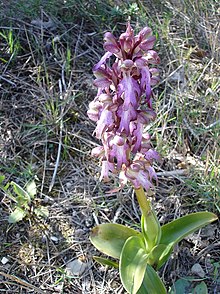Giant orchid
| Giant orchid | ||||||||||||
|---|---|---|---|---|---|---|---|---|---|---|---|---|

Giant orchid ( Himantoglossum robertianum ) |
||||||||||||
| Systematics | ||||||||||||
|
||||||||||||
| Scientific name | ||||||||||||
| Himantoglossum robertianum | ||||||||||||
| ( Loisel. ) Greuter |
The giant orchid ( Himantoglossum robertianum ; Syn .: Barlia robertiana ), also called Roberts mastorchis , is a plant species within the orchid family .
description
Vegetative characteristics
The giant orchid is a perennial herbaceous plant that reaches heights of 25 to 80 centimeters. Two underground oval tubers are formed as persistence organs.
There are two to four scale-shaped leaves at the base of the stem. There are only five to ten basal leaves . The simple leaf blade is smooth, shiny and oblong-oval with a length of up to 30 centimeters and a width of about 10 centimeters. The stem is leafless.
Generative characteristics
The giant orchid flowers generally from late December to spring. One or two narrower leaves surround the flower stem like a sheath. The racemose inflorescence contains 25 to 60 closely spaced flowers. The lower bracts are longer than the flowers. The hermaphrodite flower is zygomorphic and threefold. The three bloom of the outer circle are bent petal oval and forwardly, the middle forming two petals a type of cap. The lip is three-lobed, with the middle lobe again divided into two elongated lobes. At the bottom, the lip forms an approximately 0.5 centimeter spur with a nectarium .
The number of chromosomes is 2n = 36.
Occurrence
The distribution area extends from Morocco in the west through the Mediterranean area to southwest Turkey and Cyprus in the east. The main area of distribution is in the western Mediterranean area.
It rises from sea level to altitudes of 1700 meters. The locations are full sun to partially shaded. The soil is usually rich in bases and dry to fresh.
Systematics
It was first published in 1807 under the name ( Basionym ) Orchis robertiana by Jean-Louis-Auguste Loiseleur-Deslongchamps . The specific epithet robertianum honors the French botanist Gaspard Nicolas Robert . The name Barlia robertiana (Loisel.) Greuter is often found in literature . The new combination to Himantoglossum robertianum (Loisel.) P. Delforge was published in 1999 in Naturalistes Belges , Volume 80, p. 401. Further synonyms for Himantoglossum robertianum (Loisel.) P.Delforge are: Orchis longibracteata Biv. nom. illeg., Orchis fragrans Ten. nom. illeg., Orchis foliosa Masson ex Ker Gawl. nom. inval., Aceras longibracteatum Rchb. f. , Loroglossum longibracteatum (Rchb. F.) Moris ex Ardoino , Barlia longibracteata (Rchb. F.) Parl. , Himantoglossum longibracteatum (Rchb. F.) Schltr.
For a while it was only assumed that Barlia robertiana was closely related to the genus of the belt tongue ( Himantoglossum ). But it is accepted as Himantoglossum robertianum (Loisel.) P.Delforge .
Himantoglossum robertianum is closely related to Himantoglossum metlesicsianum (WPTeschner) P.Delforge , which occurs on Tenerife and La Palma .
Individual evidence
- ^ Barlia robertiana at Tropicos.org. In: IPCN Chromosome Reports . Missouri Botanical Garden, St. Louis
- ↑ a b c Rafaël Govaerts (Ed.): Himantoglossum robertianum. In: World Checklist of Selected Plant Families (WCSP) - The Board of Trustees of the Royal Botanic Gardens, Kew . Retrieved December 3, 2016.
- ↑ RM Bateman, PM Hollingsworth, J. Preston, YB Luo, AM Pridgeon, MW Chase: Molecular phylogenetics and evolution of Orchidinae and selected habenariinae (Orchidaceae). In: Botanical Journal of the Linnean Society , Volume 142, Issue 1, 2003, pp. 1-40. doi : 10.1046 / j.1095-8339.2003.00157.x
literature
- Helmut Baumann , Siegfried Künkele , R. Lorenz: Orchids of Europe. Ulmer Verlag, Stuttgart 2006, ISBN 3-8001-4162-0 , p. 11.
- KP Buttler: Orchids. Mosaik Verlag, Munich 1986, ISBN 3-576-10559-X , p. 152.

